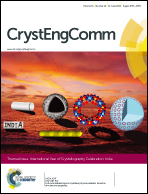Rare-earth carboxylates, [Ln2(iii)(μ3-OH)(C4H4O5)2(C4H2O4)]·2H2O [Ln = Ce, Pr and Nd]: synthesis, structure and properties†
Abstract
A new series of inorganic–organic hybrid framework compounds, Ln2(μ3-OH)(C4H4O5)2(C4H2O4)]·2H2O, (Ln = Ce, Pr and Nd), have been prepared employing a hydrothermal method. Malic acid and fumaric acid form part of the structure. The malate units connect the lanthanide centers forming Ln–O–Ln two-dimensional layers, which are cross-linked by the fumarate units forming the three-dimensional structure. Extra framework water molecules form a dimer and occupy the channels. The water molecules can be reversibly adsorbed. The dehydrated structure did not show any differences in framework structure/connectivity. The presence of lattice water provides a pathway for proton conductivity. Optical studies suggest an up-conversion behavior involving more than one photon for a neodymium compound.
![Graphical abstract: Rare-earth carboxylates, [Ln2(iii)(μ3-OH)(C4H4O5)2(C4H2O4)]·2H2O [Ln = Ce, Pr and Nd]: synthesis, structure and properties](/en/Image/Get?imageInfo.ImageType=GA&imageInfo.ImageIdentifier.ManuscriptID=C3CE42311E&imageInfo.ImageIdentifier.Year=2014)
- This article is part of the themed collection: International Year of Crystallography Celebration: India

 Please wait while we load your content...
Please wait while we load your content...